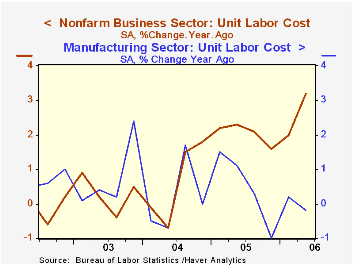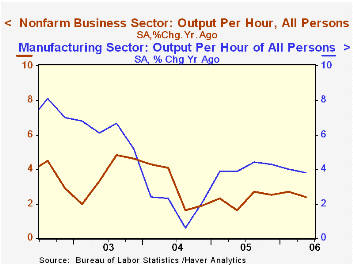 Global| Aug 08 2006
Global| Aug 08 20062Q U.S. Productivity Up 1.1%, Costs Accelerated
by:Tom Moeller
|in:Economy in Brief
Summary
Non-farm labor productivity growth last quarter slowed to 1.1% from the heady, upwardly revised 4.3% growth rate during 1Q. The gain was slightly ahead of Consensus expectations for 0.8% growth. Revisions extended back to 2003. Due to [...]

Non-farm labor productivity growth last quarter slowed to 1.1% from the heady, upwardly revised 4.3% growth rate during 1Q. The gain was slightly ahead of Consensus expectations for 0.8% growth.
Revisions extended back to 2003. Due to less output growth, as highlighted by the downward revision to GDP reported in July, productivity also was lowered to 2.3% in 2005 from 2.7% estimated initially, to 3.0% in 2004 from 3.4% and to 3.7% in 2003 from 3.9%.
Upward pressure on unit labor costs intensified due to slower productivity growth and faster growth in compensation per hour. Unit labor costs grew 4.2% last quarter, up from a 2.5% increase during 1Q. The 3.3% average rate of advance so far this year rose from 2.0% growth last year. Revisions actually lowered slightly the annual growth in costs from 2004 to 2005.
Compensation jumped 5.4% after a 6.4% 1Q gain and the 6.1% two-quarter average rate of increase is the fastest in three years. Part of the acceleration is due to downward revisions to compensation growth during 2005 and 2004.
Factory sector productivity grew 3.0% (3.8% y/y) after a 3.7% 1Q increase. Revisions to factory sector productivity also were downward. Compensation growth also was strong last quarter after downward revision to prior years' growth. Factory sector compensation per hour rose 1.7% (3.6% y/y) after a 5.2% 1Q increase that was more than double last month's estimate.
Unit labor costs in the factory sector nevertheless remained under control. Costs fell 1.2% (-0.2% y/y) after a 1.4% 1Q rise. The stability of recent labor cost pressures compares with a 0.5% gain during 2005 revised from 1.7%, and a 0.1% gain during 2004 revised from -3.1%.Colleges Need To Learn about Productivity a speech by Fed Bank President William Poole is available here.
| Non-farm Business Sector (SAAR) | 2Q' 06 | 1Q '06 | Y/Y | 2005 | 2004 | 2003 |
|---|---|---|---|---|---|---|
| Output per Hour | 1.1% | 4.3% | 2.4% | 2.3% | 3.0% | 3.7% |
| Compensation per Hour | 5.4% | 6.4% | 5.7% | 4.4% | 3.6% | 4.0% |
| Unit Labor Costs | 4.2% | 2.5% | 3.2% | 2.0% | 0.7% | 0.3% |
Tom Moeller
AuthorMore in Author Profile »Prior to joining Haver Analytics in 2000, Mr. Moeller worked as the Economist at Chancellor Capital Management from 1985 to 1999. There, he developed comprehensive economic forecasts and interpreted economic data for equity and fixed income portfolio managers. Also at Chancellor, Mr. Moeller worked as an equity analyst and was responsible for researching and rating companies in the economically sensitive automobile and housing industries for investment in Chancellor’s equity portfolio. Prior to joining Chancellor, Mr. Moeller was an Economist at Citibank from 1979 to 1984. He also analyzed pricing behavior in the metals industry for the Council on Wage and Price Stability in Washington, D.C. In 1999, Mr. Moeller received the award for most accurate forecast from the Forecasters' Club of New York. From 1990 to 1992 he was President of the New York Association for Business Economists. Mr. Moeller earned an M.B.A. in Finance from Fordham University, where he graduated in 1987. He holds a Bachelor of Arts in Economics from George Washington University.






